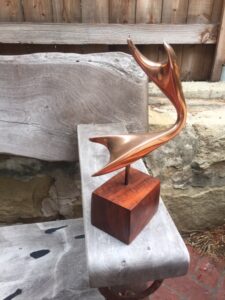 JE found this copper sculpture in a thrift store. She believes it looks like a Brancusi. It kind of does, but it misses something significant. It does not FLY.
JE found this copper sculpture in a thrift store. She believes it looks like a Brancusi. It kind of does, but it misses something significant. It does not FLY.
The claw end is a claw end (full stop), and works by Brancusi seem to embody the essence of flight. JE refers to Brancusi’s lifelong exploration into the bird in flight when she asks about this sculpture. His series, “Bird(s) in Space,” of which made many forms until he died, became world renowned.
He based his quest on his early childhood in Romania. He leaned the myth of certain golden bird that foretold the future and cured the blind. Brancusi grew up in the shadow of the Carpathian Mountains, tending sheep at age seven, finding work in the next town at nine, carving himself a violin at eleven. A kind man enrolled him in the local craft school, then he went on to art schools in Budapest, Munich, and Paris. He then found himself in Paris in the 1910s in the company of other artistic geniuses. One of which, Rodin, accepted him as apprentice. Brancusi left him fast, and said “Nothing can grow under big trees.”
Brancusi a classically trained sculptor
He found the essence of something contained in its form. When he made a model for a sculpture, he did NOT do it in clay, but hand carved it out of wood. All his life he longed for the old myths, food, and crafts of Romania. He created a monument in 1938 for Romania for the fallen soldiers of WWI who, in 1916, defended against the Central Forces. He comprised the work of three monumental sculptures: Endless Column, The Table of Silence, and The Gate of the Kiss, at Targu-Jui. Commissioned for this job that took him years to develop, when it came time for payment, he declined any compensation. I want to see those sculptures one day. After years of neglect, Romania restored them in 2000 and made them a World Heritage Site.
One of the most complex ideas in art deals with understanding when something new comes in our visual lexicon, and how viewers understand the presence of the NEW. When Brancusi first showed his work in 1920 at the Salon des Independents, organizers withdrew his sculpture Princess X. They considered it both too abstract, and too specific. The three elements of the columnar sculpture resembled a certain masculine “element.” Critics jumped all over this scandal, calling Princess X obscene. Who’s laughing now: a similar work recently sold for $71 million. Brancusi fired back calling Princess X the essence of the bosomy relative of Napoleon Bonaparte, Princess Marie Bonaparte. Brancusi explained that the base was her breasts, the shaft her neck and her downturned head reminiscent of the way she conversed with a mirror on her table, and watched her beautiful self.
Brancusi’s Battles with Critics Waged On
Turns out Princess X followed notorious Dr. Freud, and, as a woman, trained under Freud in psychoanalysis. We all know how Freud must have emphasized a certain organ that the Princess did NOT possess.
The interplay of the form of the sculpture, the “shrinking” of the actual Princess under Freud, and Brancusi’s claim that the shape was simply feminine made this work infamous. All factors which go into my assertion that JE’s sculpture cannot be Brancusi’s. Although pure in form, Brancusi’s works pack a wallop that you do not forget, like the dark shape of a flying bird seen at dusk out of the corner of your eye.
Another First
Edward Steichen early on became a fan of Brancusi’s and purchased a work in Paris and shipped it to the States. In those days they didn’t tax art imports, but US Customs said, “This piece of metal is NOT art.” They taxed Steichen at the rate taken for machinery imports. He took Customs to Court, and one wise judge said, “It’s kind of aesthetic.” From then on Customs recognized abstract sculpture as art.
JE, your piece is fine, but imagine it sculpted in 1909, and try to imagine if you would have picked it up as art in the local rag and bone shop back then!